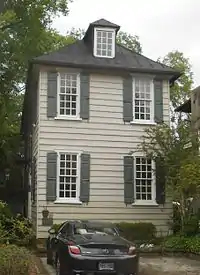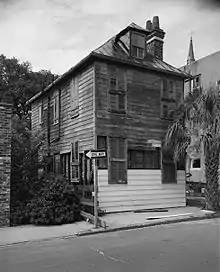Thomas Elfe House
The Thomas Elfe house is a property located in Charleston’s French Quarter at 54 Queen Street in Charleston, South Carolina. It was at one time owned by the well known colonial period furniture craftsman Thomas Elfe, whence its name. The eighteenth century house has been completely restored.
| Thomas Elfe House | |
|---|---|
 Thomas Elfe house 54 Queen St, Charleston, S.C. | |

| |
| General information | |
| Type | House |
| Construction started | 1760 |
| Technical details | |
| Structural system | Wood |
| Floor count | 2 |
Description
The property originally consisted of two buildings, one along the street front and the other on the back part of the property. [1] It is believed that the rear structure was Elfe's shop and that his home was the separate structure in front.[1] Elfe, considered to be the best Charleston furniture craftsman in the eighteenth century,[2]designed this single family house that he had built in 1760.[3] It is a colonial Georgian style house.[4] The over-all dimensions of the two story house are 16 feet, 5 3/4 inches by 30 feet, 2 1/4 inches.[5] It is two bays by three bays.[5] The main entrance to the house faces west, the street entrance for parking faces south.[5] The frame house is faced with clapboards that are 9.5 inches wide and exposed 7.75 inches, tapering from three-quarters of an inch to half an inch in thickness.[5] The clapboards are not original to the house and are replacement material of nineteenth century.[5] The house consists of two bedrooms and three bathrooms.[6] Its size is 1670 square feet (260 square meters).[6]
The house suffered little damage in the 1886 Charleston earthquake.[4] The reason surmised for this is that it is built with large heavy beams (3.5 inches X 5 inches) that are mortised and joined together with wooden pegs.[5] It also did not sustain any major damage from Hurricane Hugo, which went through the area in 1989.[4]
The Thomas Elfe house is the oldest restored historical residence in Charleston that is open to the public for visiting tours.[3] There are older house structures in Charleston, but they are either private residences or businesses.[7] The guided candlelit tours sometimes feature music of the eighteenth century.[8] The house interior is decorated to represent the period of Elfe's lifetime.[8] The house has been featured in a program for House and Garden TV and has been written about in national magazines, like Early American Life Magazine.[8] It is within walking distance of the renowned French Huguenot Church and Dock Street Theatre in Charleston's French Quarter.[8]
The house foundation has brick piers, and the property lot perimeter is partially surrounded by a brick wall.[5] In the back yard are crape myrtles and a large old live oak tree.[8] The two-story structure has four rooms. It was moved to the back of the lot by thirty feet and restored in 1968 from a badly deteriorated condition due to lack of maintenance.[8][9] The house is now a touring museum open to the public.[4] The interior represents Elfe's influence with such things as architectural features to make the rooms look bigger than they really are.
The house has two brick chimneys.[5] There is cypress cabinetry on the fireplace walls.[6][10] The chimney alcoves have built-in closets and many rooms have china cabinets decorated with antiques. [11] The house features nine-over-nine sashed windows, meaning nine panes of glass per window sash.[8] This feature is well known for older Charleston historic homes.[8]
Elfe sold the house in 1763 to Richard Hart, a chairmaker.[1] There have been many owners from that time to present.[5] The house was restored by the then present owner of the time in 1967 - 1969 to represent the eighteenth century as Elfe would have lived in it.[5] The property last sold in 2003 for a million dollars.[6]
Historic American Buildings Survey
The house is listed in the Historical American Buildings Survey of the U. S. Department of Interior.[12]


 second floor, south room
second floor, south room second floor, north room
second floor, north room first floor, south room
first floor, south room first floor, north room
first floor, north room
 54 Queen Street elevations
54 Queen Street elevations 54 Queen Street floor plans
54 Queen Street floor plans 54 Queen Street framing
54 Queen Street framing 54 Queen Street plat map
54 Queen Street plat map
See also
External links
| Wikimedia Commons has media related to Thomas Elfe house. |
Footnotes
- Humphrey 1995, p. 4.
- Foster 2005, p. 55.
- Dickinson 2001, p. 206.
- Beney 2000, p. 50.
- Stoney, Samuel G. (1963–1969). "WRITTEN HISTORICAL AND DESCRIPTIVE DATA" (PDF). Historic American Buildings Survey/Historic American Engineering Record/Historic American Landscapes Survey. Library of Congress. Archived from the original (PDF) on 2014-06-05. Retrieved 2014-06-01.
- 54-Queen-St-Charleston-SC-29401
-
"Pink House Gallery". Yelp. 2014. Retrieved 6/2/2014. Check date values in:
|accessdate=(help) - "City Walking Tour". City Walking Tours, Guides and Tips. 2014. Archived from the original on 2014-06-05. Retrieved 2014-06-01.
- Poston 1997, p. 128.
- McLaughlin 1999, p. 149.
- Perry 2007, p. 143.
- "54 Queen Street (House), Charleston, Charleston County, SC". Library of Congress. U. S. Department of Interior. 2014. Retrieved 2014-06-01.
Bibliography
- Beney, Peter (2000). Majesty of Charleston. Pelican Publishing. ISBN 978-1-4556-0813-3.CS1 maint: ref=harv (link)
- Dickinson, Joy (2001). Scarlett Slept Here: A Book Lover's Guide to the South. Kensington Publishing Corporation. ISBN 978-0-8065-2092-6.CS1 maint: ref=harv (link)
- Foster, Mary Preston (2005). Charleston: A Historic Walking Tour. Arcadia Publishing. ISBN 978-0-7385-1779-7.CS1 maint: ref=harv (link)
- Humphrey, Samuel A. (1995). Thomas Elfe, Cabinetmaker. Wyrick. ISBN 978-0-941711-15-9.CS1 maint: ref=harv (link)
- McLaughlin, J. Michael (1999). The Insiders' guide to Greater Charleston. Insiders' Publishing, Incorporated. ISBN 978-1-57380-088-4.CS1 maint: ref=harv (link)
- Perry, Lee Davis (2007). Insiders' Guide to Charleston: Including Mt. Pleasant, Summerville, Kiawah, and Other Islands. Globe Pequot Press. ISBN 978-0-7627-4403-9.CS1 maint: ref=harv (link)
- Poston, Jonathan H. (1997). The Buildings of Charleston: A Guide to the City's Architecture. University of South Carolina Press. ISBN 978-1-57003-202-8.CS1 maint: ref=harv (link)